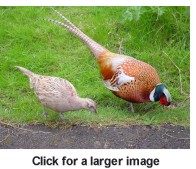 For example, in some species, including many mammals, the male is larger than the female. In others, such as some spiders, the female is larger than the male. Other sex-specific differences include color (most birds), song in birds, size or presence of parts of the body used in struggles for dominance, such as horns, antlers, and tusks; size of the eyes (e.g., in the case of bees); possession of stings (various kinds of bees), and different thresholds for certain behaviors (aggression, infant care, etc.).
For example, in some species, including many mammals, the male is larger than the female. In others, such as some spiders, the female is larger than the male. Other sex-specific differences include color (most birds), song in birds, size or presence of parts of the body used in struggles for dominance, such as horns, antlers, and tusks; size of the eyes (e.g., in the case of bees); possession of stings (various kinds of bees), and different thresholds for certain behaviors (aggression, infant care, etc.).Sexual dimorphism in humans is the subject of much controversy. Human male and female appearances are perceived as different, although Homo sapiens has a low level of sexual dimorphism compared with many other species. The similarity in the sizes of male and female human beings is a good example of how nature often does not make clear divisions. To give an accurate picture of male and female size differences one would need to show how many individuals there are in each size category. There is a considerable overlap.
For example, the body masses of both male and female humans are approximately normally distributed. In the United States, the mean mass of an adult male is 78.5 kg, while the adult female mean is 62.0 kg. However the standard deviation of male body mass is 12.6 kg, so 10% of adult males are actually lighter than the female average.
Biological aspects of sexual dimorphism
The phenomenon of sexual dimorphism is a direct product of evolution by natural selection, in that the struggle for reproductive success drives many male and female organisms down different evolutionary paths. This can produce forms of dimorphism which, on the face of it, would actually seem to disadvantage organisms. For instance, the bright coloration of male game birds makes them highly visible targets for predators, while the drab females are far better equipped to camouflage themselves. Likewise, the antlers of deer and other forms of natural weaponry are very expensive to grow and carry in terms of the energy consumed by the animal in the process.
 The answer to this apparent paradox is that, at a biological level, the reproductive success of an organism is often more important than its long-term survival. This is particularly apparent in the case of game birds: a male Common Pheasant in the wild often lives no more than 10 months, with females living twice as long. However, a male pheasant's ability to reproduce depends not on how long he lives but whether females will select him to be their mate. His bright coloration demonstrates to the female that he is fit, healthy and a good choice to father her chicks.
The answer to this apparent paradox is that, at a biological level, the reproductive success of an organism is often more important than its long-term survival. This is particularly apparent in the case of game birds: a male Common Pheasant in the wild often lives no more than 10 months, with females living twice as long. However, a male pheasant's ability to reproduce depends not on how long he lives but whether females will select him to be their mate. His bright coloration demonstrates to the female that he is fit, healthy and a good choice to father her chicks.In the case of herd animals such as deer, a male deer's reproductive success is directly proportional to the number of sexually receptive females with which he can mate. The males' antlers are an example of a sexually dimorphic weapon with which the males fight each other to establish breeding rights. Again, although they are expensive in terms of personal survival, they ensure that the largest and strongest males will be the most successful in reproducing and thereby ensure that those characteristics are passed on to the next generation.
Access to the opposite sex is not the only reason why sexual dimorphism exists. In insects in particular, females are often larger than the males.
 It is thought that the reason lies in the huge number of eggs that insects lay; a larger body size enables a female insect to lay more eggs. In some cases, sexual dimorphism enables males and females to exploit different food resources, thus increasing their collective ability to find food. Some species of woodpecker have differently-sized and shaped beaks, enabling the sexes to find insects in different layers of a tree's bark.
It is thought that the reason lies in the huge number of eggs that insects lay; a larger body size enables a female insect to lay more eggs. In some cases, sexual dimorphism enables males and females to exploit different food resources, thus increasing their collective ability to find food. Some species of woodpecker have differently-sized and shaped beaks, enabling the sexes to find insects in different layers of a tree's bark.It is also common in birds of prey for the female to be larger than the male, an example of reverse sexual dimorphism. The size difference allows the mated pair to hunt a greater variety of prey for themselves and for their chicks.
sexual dimorphism